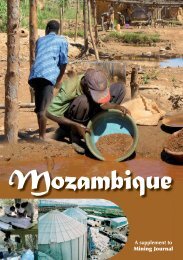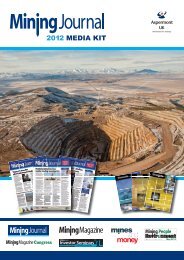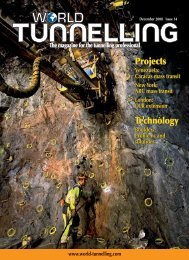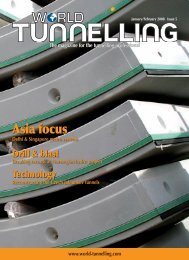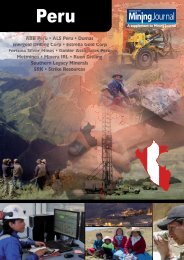Tungsten - Mining Journal
Tungsten - Mining Journal
Tungsten - Mining Journal
Create successful ePaper yourself
Turn your PDF publications into a flip-book with our unique Google optimized e-Paper software.
2<br />
OVERVIEW<br />
CONTENTS<br />
Overview 2-4<br />
Exploration 5-6<br />
Map 8-9<br />
Profi les:<br />
Amanta Resources 7<br />
Geodex Minerals 10<br />
Malaga 11<br />
North American <strong>Tungsten</strong> 12<br />
Oriental Resources 13<br />
Ormonde <strong>Mining</strong> 14<br />
Queensland Ores 15<br />
Cover: montage of scheelite and tungsten images,<br />
with ‘w’ the chemical symbol for wolfram<br />
Photo: North American <strong>Tungsten</strong><br />
Published in June 2008 by:<br />
<strong>Mining</strong> Communications Ltd<br />
Albert House, 1 Singer Street<br />
London EC2A 4BQ<br />
Tel: +44 (0)20 7216 6060 Fax: +44 (0)20 7216 6050<br />
E-mail: editorial@mining-journal.com<br />
Website: www.mining-journal.com<br />
Supplement editor: Chris Hinde<br />
Design and production: Tim Peters,<br />
Karen Leverington, Vickie Johnstone<br />
Printed by Latimer Trend, Plymouth, UK<br />
© <strong>Mining</strong> Communications Ltd 2008<br />
An Aspermont company<br />
ITIA<br />
The International <strong>Tungsten</strong> Industry Association<br />
was inaugurated in Brussels in February 1988, and<br />
is registered as an association with scientifi c<br />
purposes under Belgian law. The members of ITIA,<br />
from 17 countries, include mining companies,<br />
processors/consumers, trading companies and<br />
assayers. Website: www.itia.org.uk<br />
scheelite<br />
concentrate<br />
primary tungsten<br />
(concentrates)<br />
66%<br />
� nal<br />
product<br />
90%<br />
loss through<br />
dissipation & discard<br />
55%<br />
wolframite<br />
concentrate<br />
TOTAL TUNGSTEN DEMAND<br />
scrap from used parts<br />
24%<br />
June 2008 <strong>Mining</strong> <strong>Journal</strong> special publication <strong>Tungsten</strong><br />
Heavy stone<br />
The name tungsten is taken from the Swedish for<br />
heavy stone (tung sten), but the element is also<br />
widely referred to as wolfram after one of its ores<br />
Although not isolated until 225 years<br />
ago, tungsten has a history dating<br />
back to before Georg Agricola, who is<br />
thought to have described the ore in<br />
1546. Tin miners extracting cassiterite<br />
in the Erz Mountains of Saxony in the 17th century<br />
noted that certain ores reduced the amount of tin recovered<br />
“like a wolf devours a sheep” (the effect of the<br />
ore being likened to wolf’s froth, volf rahm in German).<br />
In 1758, the Swedish chemist and mineralogist,<br />
Axel Fredrik Cronstedt, discovered and described an<br />
unusually heavy mineral that he called ‘tung sten’. Although<br />
he was convinced that this mineral contained<br />
a new and as yet undiscovered element, it was not<br />
until 1781 that a fellow Swede, Carl Wilhelm Scheele<br />
(who worked as a pharmacist and private tutor in<br />
Uppsala and Köping) succeeded in isolating the oxide<br />
(tungsten trioxide).<br />
Torbern Bergman, working at Uppsala, predicted<br />
that the acid isolated by Mr Scheele contained a new<br />
metal, which should be possible to prepare by coal<br />
reduction. One year later, a Spanish nobleman,<br />
Don Juan José de Elhuyar, studied at the University of<br />
Uppsala under Bergman. Back in Spain in 1783, Juan<br />
José and his brother, Fausto de Elhuyar de Suvisa,<br />
were the fi rst to prepare tungsten metal by the<br />
method suggested by Bergman. They named it wolfram.<br />
Jöns Jacob Berzelius (1816), and later Friedrich<br />
Wöhler (1824), described the oxides and bronzes of<br />
tungsten, and also proposed the name wolfram.<br />
In 1821, KC von Leonhard proposed the name<br />
scheelite for the mineral CaWO4. In 1847, R Oxland<br />
took out a patent for the manufacture of sodium<br />
tungstate and tungstic acid. This forms the starting<br />
point of the metallurgy of tungsten.<br />
Industry schematic<br />
secondary tungsten<br />
(concentrates)<br />
34%<br />
scrap from<br />
processing<br />
10%<br />
CONVERSION<br />
<strong>Tungsten</strong> conversion measurements<br />
W 1.2616 WO3<br />
Ton 2,000lb<br />
Ton 0.907t<br />
Tonne 2,204.6lb<br />
Tonne 100MTU (metric tonne units)<br />
Short ton unit 20lb (1% short ton)<br />
MTU 1.1023STU<br />
MTU 10kg (1% metric tonne)<br />
MTU 22.04lb<br />
The fi rst attempts to produce tungsten steel<br />
were made in 1855 by J Jacob and F Koeller at the<br />
Reichraming steel works in Austria. Further improvements<br />
in alloying and hardening of steels by tungsten<br />
were made late in the 19th century, and rapid growth<br />
and widespread application followed. The launch of<br />
high-speed steels by Bethlehem Steel took place in<br />
1900 at the World Exhibition in Paris.<br />
The second important breakthrough in tungsten<br />
applications was made by WD Coolidge in 1908<br />
and 1909. Mr Coolidge succeeded in preparing a<br />
ductile tungsten wire by thermo-mechanical<br />
processing. Metal powder (WC) was pressed to<br />
bars, sintered and forged to thin rods. Very thin<br />
wire was then drawn from these rods. This was the<br />
beginning of tungsten-powder metallurgy, which was<br />
instrumental in the rapid development of the lamp<br />
industry.<br />
The next important milestone in the chronology<br />
of tungsten is 1923, which marks the invention of<br />
hard-metal (combining WC and cobalt by liquid-phase<br />
sintering) by K Schröter. The corresponding<br />
application for a patent was granted to Osram<br />
Studiengesellschaft in Berlin, and licensed to Krupp in<br />
Essen in 1926. Hard-metal (cemented carbide) is now<br />
the main application for tungsten.<br />
HISTORY LESSON<br />
The brothers José and Fausto Elhuyar are credited<br />
with the discovery of the element in Spain<br />
during 1783. They had found an acid made from<br />
wolframite that was identical to an acid made<br />
from scheelite (tungstic acid), and subsequently<br />
succeeded in isolating tungsten through reduction<br />
of this acid with charcoal.<br />
Carl Wilhelm Scheele had ascertained two<br />
years earlier that a new acid (at the time named<br />
tungstenite) could be made from scheelite. Mr<br />
Scheele and Torbern Bergman suggested that<br />
it could be possible to obtain a new metal by<br />
reducing this acid.



